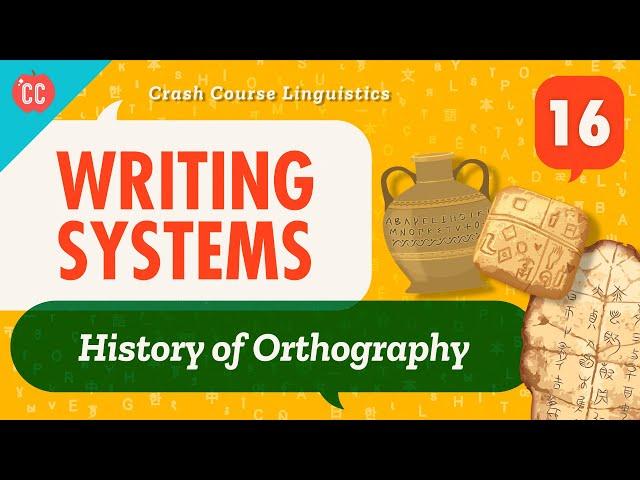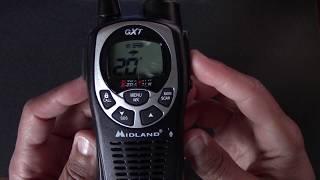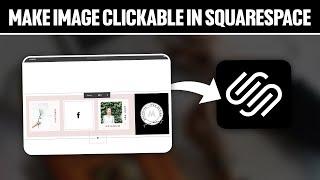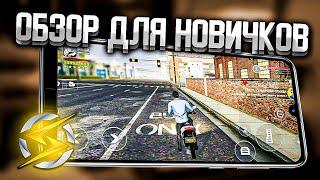
Writing Systems: Crash Course Linguistics #16
Комментарии:

I'm designing my curriculum for my Korean students and seeing Hangul mentioned made me really happy and want to fit this video into my lesson plan 😊
Ответить
thank yooouuuu
Ответить
Cool! I want to know how many courses there are
Ответить
Very old video
Ответить
Thirsty to learn, that’s why here i’m ,would be be great if crash course have graphic design in channel, that would expand our learning so broad!
Ответить
Oops now I want to change my major
Ответить
Great video.
Ответить
Shakespeare made spelling mistakes while writing own name 😮
Ответить
Absolutely lost it at Willm Shakp. Thank you so much for a wonderful series!!
Ответить
Will there be a series on Art History?
Ответить
How could you know so much about language and still pronounce GIF wrong? xD
Ответить
Thes...pass...e...though.
See? New languages can hide into the realm of phonetics 😄

thank you. it is quite a sudden that the course stopped here. I thought there are still a lot more things to go through. Anyway, thank you for the contritbution. it has been a great journey learning all these cool things.
Ответить
A linguistics video, and she says "jif"
Yikes

What a great series, learned a lot!
Ответить
Its over already :(
Ответить
This was great! I loved this! Taylor, you were a great host! Sad to see this series go!
Ответить
Absolutely loved this series
Ответить
This course was awesome
Ответить
Great series!
Ответить
Yes, each character in Chinese represents a word or complete idea. One thing that helps with understanding, though, is that more complex characters can contain pieces of simpler characters. For example home (家) contains roof (宀) and pig (豕).
Ответить
thank you for the series! one of my favs from Crash Course. Taylor did a great job!
Ответить
Thanks so much to everyone who worked on this series. I loved it.
Ответить
What!?? No, don't leave us! I mean I know Taylor isn't leaving, but I also love this show!
Ответить
Hey, thanks for the video; just a remark. SINGLE SOUND ARE NOT PHONEMES; PHONEMES CAN IMPLY VARIOUS DIFFERENT SOUNDS DEPENDING ON THE LANGUAGE WE ARE TALKING ABOUT :)
Ответить
Nooo last episode already? I hope you consider making a part two of this, there is so much more linguistics to cover! Thanks for the great content Taylor!
Ответить
Thanks to the CrashCourse team for this really fun and interesting course!!! :D
Ответить
What a series, thanks T!
Ответить
Given that first hieroglyphs are somewhat older than the first cuneiform the theory for borrowing into Egyptian of the Sumerian system is rather unprecise.
Ответить
relaxing sounds from nature for you
Ответить
Do a crash course architecture
Ответить
Me on episode 1: I'm not interested in linguistics but I guess I'll watch to support the channel, maybe I'll learn something new.
Me on episode 16: Turns out linguistics is a really interesting field! There is so much to learn.

I'm curious as to why you chose to describe many Indian writing systems and Inuktitut as "syllabaries". I've always heard them described as "abugidas" before, which is a major type of writing system that this video didn't even mention.
Ответить
Very interesting and worthwhile video. Excellent introduction.
Ответить
omg is this already the last episode??? imma gonna cry
Ответить
Thank you for an excellent series. Hope to see you on CC again soon.
Ответить
They covered a lot in 16 episodes but there is so much more
Ответить
Shakespeare: no
Jacques-Pierre: better
Iacobus-Petrus: YES

I loved this course. It's not that I learned so many new things, since I've been following the subject for many years, but the way it was presented and explained... I found it very inspirational. I really hope that you get into linguistics again soon.
Ответить
Thank you so much for another valuable and informative series ❤️
Ответить
Last???????
Ответить
Taylor's a really good host/presenter, so I hope she gets another Crash Course series soon!
Ответить
what about braille
Ответить
Last episode?! Nooooooo
Ответить
Last what!!? Like whaaaat!?
Ответить
It is now broadly accepted (following Edward Catich) that Roman letters were first written with a brush on the stone before being carved into stone. The same thing happened with Chinese characters, which were carved in stone just like they were written with a brush. The more pronounced rationalization of the Roman letterforms came much later starting in the Age of Enlightenment typefaces such as the Romain du Roi. Something similar happened to Chinese characters in printing, with the forms becoming more and more regular with straight lines until they looked very different from the forms written with a brush. So the explanation in the video is just wrong here. Better examples would have been Runic alphabets using only vertical and diagonal strokes or many Indic scripts such as Tamil and Balinese which favoured curved strokes so as not to damage the palm leaves they were written on.
Ответить
I was surprised the Nāgarī script was called a syllabary. It is a prototypical example of an abugida, a category that has features of both an alphabet and a syllabary and is contrasted with both by specialists. It is ultimately derived from an abjad (probably Aramaic) with vowel signs added on, so it is very different in origin from true syllabaries like the Japanese kanas.
Inuktitut syllabics are also an abugida, though at least there is the excuse that the name makes it sound like a syllabary. But I have never seen the Indic scripts referred to as syllabaries. Abugidas are also called alphasyllabaries, so maybe that's where the confusion came from. Given the prominence of abugidas in several regions of the world (including Southeast Asia and the Horn of Africa), it would have been nice to treat them separately.
Also, while talking about the Nāgarī syllabary (sic), the examples shown were of Devanagari script, one of the modern descendants of Nāgarī script. Why not just call it the Devanagari script, since that is the name most used in English? Why use a name that strictly refers to one of the early stages of the script, even if it is sometimes used interchangeably with Devanagari? If you wanted to cover all such writing systems in the region you could have referred to the Brahmic scripts or Indic scripts.

MALK. Now with vitamin R
Ответить

























